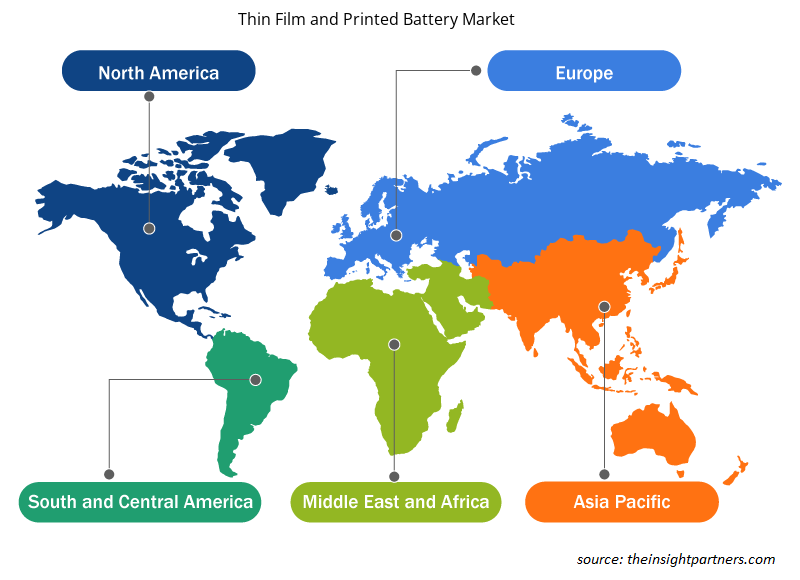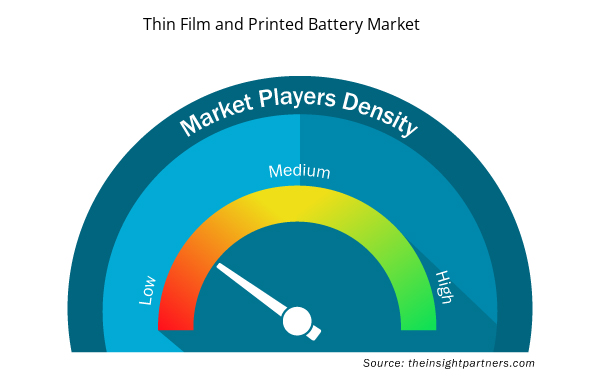薄膜和印刷电池市场规模预计将从 2023 年的 1.9731 亿美元增至 2031 年的 9.0494 亿美元。预计 2023-2031 年期间市场复合年增长率将达到 21.0%。电子产品小型化可能仍是市场的主要趋势。
薄膜和印刷电池市场分析
薄膜电池因其充电速度快、体积小等优点,越来越多地用于健身手环、智能手表、耳机和其他可穿戴电子设备。此外,5G 的日益普及也提高了对联网电子设备的需求。此外,智能卡(如 EMV 芯片卡技术)的使用日益增多,推动了全球对薄膜和印刷电池的需求。由于智能卡是在 130-150 摄氏度的高温下制造的,这会降低普通电池中的有机物含量并使其无法正常工作,因此,智能卡生产对薄膜和印刷电池的需求正在增加。此外,电子设备的日益小型化预计将在预测期内为薄膜和印刷电池市场创造增长机会。
薄膜和印刷电池市场概况
薄膜电池是尺寸从纳米到毫米的固态电池。它们由阳极、阴极、电解质和隔膜组成。薄膜锂离子电池比普通锂离子电池性能更好,因为它们的平均输出电压更高、重量更轻、能量密度更高、循环寿命更长,并且能够在 -20°C 至 60°C 的温度范围内工作。这些电池用于各种应用,包括智能卡、无线传感器、笔记本电脑、触摸屏、天文镜、RFID 标签、光伏能源生成和存储以及可植入设备。
定制此报告以满足您的需求
您可以免费定制任何报告,包括本报告的部分内容、国家级分析、Excel 数据包,以及为初创企业和大学提供优惠和折扣
- 获取此报告的关键市场趋势。这个免费样品将包括数据分析,从市场趋势到估计和预测。
薄膜和印刷电池市场驱动因素和机遇
5G 的出现推动薄膜和印刷电池市场的增长
5G网络比4G网络快约100倍,使实时数据采集更加容易。由于5G网络提供了强大的连接能力和高速的数据传输,全球对其的需求正在增加。根据全球移动通信系统协会(GSMA)的数据,全球5G普及率预计将从2022年的17%达到2030年的54%。北美的5G普及率最高,2022年为39%;预计到2030年将达到91%。亚太地区(中国除外)和欧洲的5G普及率预计将分别从2022年的4%和11%增加到2030年的41%和87%。由于5G是能够实现创新和支持数字化转型的关键的新一代网络技术,因此全球对其的需求正在增加。因此,各国政府都在投资5G基础设施。 2021 年 7 月,法国政府宣布计划到 2025 年通过公共和私人投资向其 5G 市场投资约 20.6 亿美元(17 亿欧元)。政府旨在通过此举加速该国 5G 的发展。同样,2021 年 1 月,韩国政府宣布今年将把下一代移动网络(尤其是 5G)的覆盖范围从目前的 7 个主要城市扩大到 85 个城市。2021 年,韩国政府投资约 1.1589 亿美元(1279 亿韩元)以鼓励使用私有 5G 网络。随着 5G 在全球范围内的日益普及,对联网电子设备的需求也在不断增加,从而推动了薄膜和印刷电池市场的增长。
持续研发
由于对可持续性的关注度不断提高,研究人员正致力于开发高效的电池技术,该技术可以以环保的方式制造,并具有增强安全性、更快的充电时间、耐高温和防火等特点。他们强调在薄膜和印刷电池的生产过程中不使用任何有毒溶剂。此外,他们更专注于开发比锂离子电池更高效的电池。因此,他们正在寻找能够为此类电池的研发提供所需资金的投资者。他们计划将它们推向市场,以满足可穿戴设备、智能卡、电子产品和 RFID 标签等应用对高效电池解决方案的需求。例如,2023 年 9 月,位于苏黎世州的瑞士联邦材料科学与技术实验室 (Empa) 的衍生公司 BTRY 宣布了其计划,通过创新的薄膜电池推动下一代电池技术的发展。Empa 的研究人员开发了一种基于锂金属的固态电池。有了它,他们可以将薄膜电池堆叠在一起以增强存储容量。
制造工艺是根据半导体芯片生产中使用的真空涂层来决定的。此外,BTRY 正在寻找投资者进行管理和技术改进,以将该技术推向市场。这包括使电池原型更大、更强大。因此,这种先进电池解决方案的研发有望为其推出做出贡献,这进一步为薄膜和印刷电池市场及其广泛采用的增长创造了机会。
薄膜和印刷电池市场报告细分分析
有助于薄膜和印刷电池市场分析的关键部分是额定电压、可变性和应用。
- 根据额定电压,薄膜和印刷电池市场分为 1.5 V 以下、1.5-3 V 和 3 V 以上。1.5 V 以下部分在 2023 年占据了最大的市场份额。由于其低电压输出,1.5 V 以下薄膜电池适用于低压应用。这些电池主要用于便携式电子设备,例如遥控器、手电筒和玩具。
- 就可充电性而言,市场分为可充电和一次性使用。可充电部分在 2023 年占据了更大的市场份额。2023 年智能社会的最新研究和发展需要将智能设备与更高的安全性、比能、功率和更小尺寸的材料相结合。这导致了对用于电能存储的薄膜可充电电池的需求,这些电池具有良好的能量和功率密度、机械强度、良好而长的循环寿命以及可观的温度耐受性,适用于小型便携式消费电子产品,特别是在手机、移动应用、笔记本电脑和笔记本电脑、智能卡、电动汽车、通信和其他电气设备中。
- 在应用方面,市场细分为消费电子、医疗设备、智能包装、智能卡、无线传感器等。消费电子领域在 2023 年占据了最大的市场份额。特别是柔性薄膜电池在消费电子或可穿戴设备领域也具有巨大潜力。由于其适应性强的形状和坚固性,它们可以完美地融入电子设备并作为能源。
薄膜和印刷电池市场份额按地区分析
薄膜和印刷电池市场报告的地理范围主要分为五个地区:北美、亚太、欧洲、中东和非洲、南美和中美。
由于消费电子产品小型化趋势日益明显,北美市场正在经历显著增长。随着消费者寻求更小、更便携的电子设备,对紧凑高效电源的需求也日益增加。此外,物联网和智能设备的普及是推动北美市场发展的另一个关键因素。物联网设备在医疗保健、交通运输和智能家居应用等行业中的应用日益广泛,为该地区的薄膜和印刷电池制造商创造了巨大的机会。此外,Molex LLC、Excellatron Solid State, LLC、Ultralife Corporation 和 Imprint Energy 等市场参与者的存在促进了北美薄膜和印刷电池市场的发展。
在欧洲,薄膜和印刷电池的多种应用(例如智能卡、智能包装、医疗设备和消费电子产品)正在引领市场增长。Varta AG、Ilika、RENATA SA 和 STMicroelectronics 等市场参与者正在实施多种有机和无机战略来提高收入。该地区消费电子市场的激增推动了对柔性电池解决方案的需求。该地区对智能包装解决方案的需求不断增长,预计将为薄膜和印刷电池市场的增长提供巨大的机会。此外,该地区的研究人员专注于推出创新的电池解决方案,这有助于薄膜和印刷电池市场的增长。
在亚太地区,印度和中国等经济体正致力于提高消费电子等领域的国内生产。各种激励计划和外商直接投资预计将吸引制造商在该地区设立制造部门。此外,该地区人民可支配收入的提高和人口的增长促进了可穿戴技术的采用和消费电子市场的增长。医疗保健行业的数字化也促进了亚太地区薄膜和印刷电池市场的增长。
薄膜和印刷电池市场区域洞察
Insight Partners 的分析师已详尽解释了预测期内影响薄膜和印刷电池市场的区域趋势和因素。本节还讨论了北美、欧洲、亚太地区、中东和非洲以及南美和中美洲的薄膜和印刷电池市场细分和地理位置。

- 获取薄膜和印刷电池市场的区域特定数据
薄膜和印刷电池市场报告范围
| 报告属性 | 细节 |
|---|---|
| 2023 年的市场规模 | 1.9731亿美元 |
| 2031 年市场规模 | 9.0494亿美元 |
| 全球复合年增长率(2023 - 2031) | 21.0% |
| 史料 | 2021-2022 |
| 预测期 | 2023-2031 |
| 涵盖的领域 | 按额定电压
|
| 覆盖地区和国家 | 北美
|
| 市场领导者和主要公司简介 |
|
薄膜和印刷电池市场参与者密度:了解其对业务动态的影响
薄膜和印刷电池市场正在快速增长,这得益于终端用户需求的不断增长,而这些需求又源于消费者偏好的不断变化、技术进步以及对产品优势的认识不断提高等因素。随着需求的增加,企业正在扩大其产品范围,进行创新以满足消费者的需求,并利用新兴趋势,从而进一步推动市场增长。
市场参与者密度是指在特定市场或行业内运营的企业或公司的分布情况。它表明在给定市场空间中,相对于其规模或总市场价值,有多少竞争对手(市场参与者)存在。
在薄膜和印刷电池市场运营的主要公司有:
- 莫仕有限公司
- 瓦尔塔股份公司
- 雷纳塔公司
- Enfucell柔性电子有限公司
- 意法半导体公司
- 三星SDI有限公司
免责声明:上面列出的公司没有按照任何特定顺序排列。

- 了解薄膜和印刷电池市场的主要参与者概况
薄膜和印刷电池市场新闻和最新发展
薄膜和印刷电池市场的评估是通过收集一手和二手研究后的定性和定量数据进行的,其中包括重要的公司出版物、协会数据和数据库。以下列出了薄膜和印刷电池市场的一些发展情况:
- 瑞士联邦材料科学与技术实验室 (EMPA) 的研究人员团队成立了一家名为 BTRY 的衍生公司,旨在将其固态电池推向市场。该公司将使用真空涂层制造薄膜电池,其中所需材料在真空室中雾化以形成单个原子。然后,这些原子沉积在目标基板上的精确控制层中。
(来源:EMPA,新闻稿,2023 年 9 月)
薄膜和印刷电池市场报告范围和交付成果
“薄膜和印刷电池市场规模和预测(2021-2031)”报告对以下领域进行了详细的市场分析:
- 薄膜和印刷电池市场规模以及全球、区域和国家层面所有关键细分市场的预测
- 薄膜和印刷电池市场趋势,以及驱动因素、限制因素和关键机遇等市场动态
- 详细的 PEST/波特五力分析和 SWOT 分析
- 薄膜和印刷电池市场分析涵盖主要市场趋势、全球和区域框架、主要参与者、法规和最新市场发展
- 行业格局和竞争分析,涵盖市场集中度、热图分析、知名参与者以及薄膜和印刷电池市场的最新发展
- 详细的公司简介
- 历史分析(2 年)、基准年、预测(7 年)及复合年增长率
- PEST 和 SWOT 分析
- 市场规模价值/数量 - 全球、区域、国家
- 行业和竞争格局
- Excel 数据集


- Resistance Bands Market
- Electronic Toll Collection System Market
- Wire Harness Market
- Aesthetic Medical Devices Market
- Employment Screening Services Market
- Antibiotics Market
- Equipment Rental Software Market
- Energy Recovery Ventilator Market
- Semiconductor Metrology and Inspection Market
- Europe Surety Market

Report Coverage
Revenue forecast, Company Analysis, Industry landscape, Growth factors, and Trends

Segment Covered
This text is related
to segments covered.

Regional Scope
North America, Europe, Asia Pacific, Middle East & Africa, South & Central America

Country Scope
This text is related
to country scope.
常见问题
The Asia Pacific held the largest market share in 2023, followed by North America and Europe.
Miniaturization of electronics is the future trends of the thin film and printed battery market.
The thin film and printed battery market was valued at US$ 197.31 million in 2023 and is projected to reach US$ 904.94 million by 2031; it is expected to grow at a CAGR of 21.0% during 2023–2031.
Asia Pacific is anticipated to grow with the highest CAGR over the forecast period 2024-2031.
The key players, holding majority shares, in thin film and printed battery market includes STMicroelectronics; Varta AG; Ultralife Corporation; Samsung SDI Co.,Ltd.; and Molex LLC.
Proliferation of 5G, rising demand for wearable devices, and growing focus on sustainability are the driving factors impacting the thin film and printed battery market.
Trends and growth analysis reports related to Electronics and Semiconductor : READ MORE..
The List of Companies - Thin Film and Printed Batteries Market
- Molex LLC
- Varta AG
- RENATA SA
- Enfucell Flexible Electronics Ltd
- STMicroelectronics NV
- Samsung SDI Co Ltd
- Ultralife Corp
- Ilika plc
- Imprint Energy
- Excellatron
The Insight Partners performs research in 4 major stages: Data Collection & Secondary Research, Primary Research, Data Analysis and Data Triangulation & Final Review.
- Data Collection and Secondary Research:
As a market research and consulting firm operating from a decade, we have published and advised several client across the globe. First step for any study will start with an assessment of currently available data and insights from existing reports. Further, historical and current market information is collected from Investor Presentations, Annual Reports, SEC Filings, etc., and other information related to company’s performance and market positioning are gathered from Paid Databases (Factiva, Hoovers, and Reuters) and various other publications available in public domain.
Several associations trade associates, technical forums, institutes, societies and organization are accessed to gain technical as well as market related insights through their publications such as research papers, blogs and press releases related to the studies are referred to get cues about the market. Further, white papers, journals, magazines, and other news articles published in last 3 years are scrutinized and analyzed to understand the current market trends.
- Primary Research:
The primarily interview analysis comprise of data obtained from industry participants interview and answers to survey questions gathered by in-house primary team.
For primary research, interviews are conducted with industry experts/CEOs/Marketing Managers/VPs/Subject Matter Experts from both demand and supply side to get a 360-degree view of the market. The primary team conducts several interviews based on the complexity of the markets to understand the various market trends and dynamics which makes research more credible and precise.
A typical research interview fulfils the following functions:
- Provides first-hand information on the market size, market trends, growth trends, competitive landscape, and outlook
- Validates and strengthens in-house secondary research findings
- Develops the analysis team’s expertise and market understanding
Primary research involves email interactions and telephone interviews for each market, category, segment, and sub-segment across geographies. The participants who typically take part in such a process include, but are not limited to:
- Industry participants: VPs, business development managers, market intelligence managers and national sales managers
- Outside experts: Valuation experts, research analysts and key opinion leaders specializing in the electronics and semiconductor industry.
Below is the breakup of our primary respondents by company, designation, and region:

Once we receive the confirmation from primary research sources or primary respondents, we finalize the base year market estimation and forecast the data as per the macroeconomic and microeconomic factors assessed during data collection.
- Data Analysis:
Once data is validated through both secondary as well as primary respondents, we finalize the market estimations by hypothesis formulation and factor analysis at regional and country level.
- Macro-Economic Factor Analysis:
We analyse macroeconomic indicators such the gross domestic product (GDP), increase in the demand for goods and services across industries, technological advancement, regional economic growth, governmental policies, the influence of COVID-19, PEST analysis, and other aspects. This analysis aids in setting benchmarks for various nations/regions and approximating market splits. Additionally, the general trend of the aforementioned components aid in determining the market's development possibilities.
- Country Level Data:
Various factors that are especially aligned to the country are taken into account to determine the market size for a certain area and country, including the presence of vendors, such as headquarters and offices, the country's GDP, demand patterns, and industry growth. To comprehend the market dynamics for the nation, a number of growth variables, inhibitors, application areas, and current market trends are researched. The aforementioned elements aid in determining the country's overall market's growth potential.
- Company Profile:
The “Table of Contents” is formulated by listing and analyzing more than 25 - 30 companies operating in the market ecosystem across geographies. However, we profile only 10 companies as a standard practice in our syndicate reports. These 10 companies comprise leading, emerging, and regional players. Nonetheless, our analysis is not restricted to the 10 listed companies, we also analyze other companies present in the market to develop a holistic view and understand the prevailing trends. The “Company Profiles” section in the report covers key facts, business description, products & services, financial information, SWOT analysis, and key developments. The financial information presented is extracted from the annual reports and official documents of the publicly listed companies. Upon collecting the information for the sections of respective companies, we verify them via various primary sources and then compile the data in respective company profiles. The company level information helps us in deriving the base number as well as in forecasting the market size.
- Developing Base Number:
Aggregation of sales statistics (2020-2022) and macro-economic factor, and other secondary and primary research insights are utilized to arrive at base number and related market shares for 2022. The data gaps are identified in this step and relevant market data is analyzed, collected from paid primary interviews or databases. On finalizing the base year market size, forecasts are developed on the basis of macro-economic, industry and market growth factors and company level analysis.
- Data Triangulation and Final Review:
The market findings and base year market size calculations are validated from supply as well as demand side. Demand side validations are based on macro-economic factor analysis and benchmarks for respective regions and countries. In case of supply side validations, revenues of major companies are estimated (in case not available) based on industry benchmark, approximate number of employees, product portfolio, and primary interviews revenues are gathered. Further revenue from target product/service segment is assessed to avoid overshooting of market statistics. In case of heavy deviations between supply and demand side values, all thes steps are repeated to achieve synchronization.
We follow an iterative model, wherein we share our research findings with Subject Matter Experts (SME’s) and Key Opinion Leaders (KOLs) until consensus view of the market is not formulated – this model negates any drastic deviation in the opinions of experts. Only validated and universally acceptable research findings are quoted in our reports.
We have important check points that we use to validate our research findings – which we call – data triangulation, where we validate the information, we generate from secondary sources with primary interviews and then we re-validate with our internal data bases and Subject matter experts. This comprehensive model enables us to deliver high quality, reliable data in shortest possible time.


 获取此报告的免费样本
获取此报告的免费样本